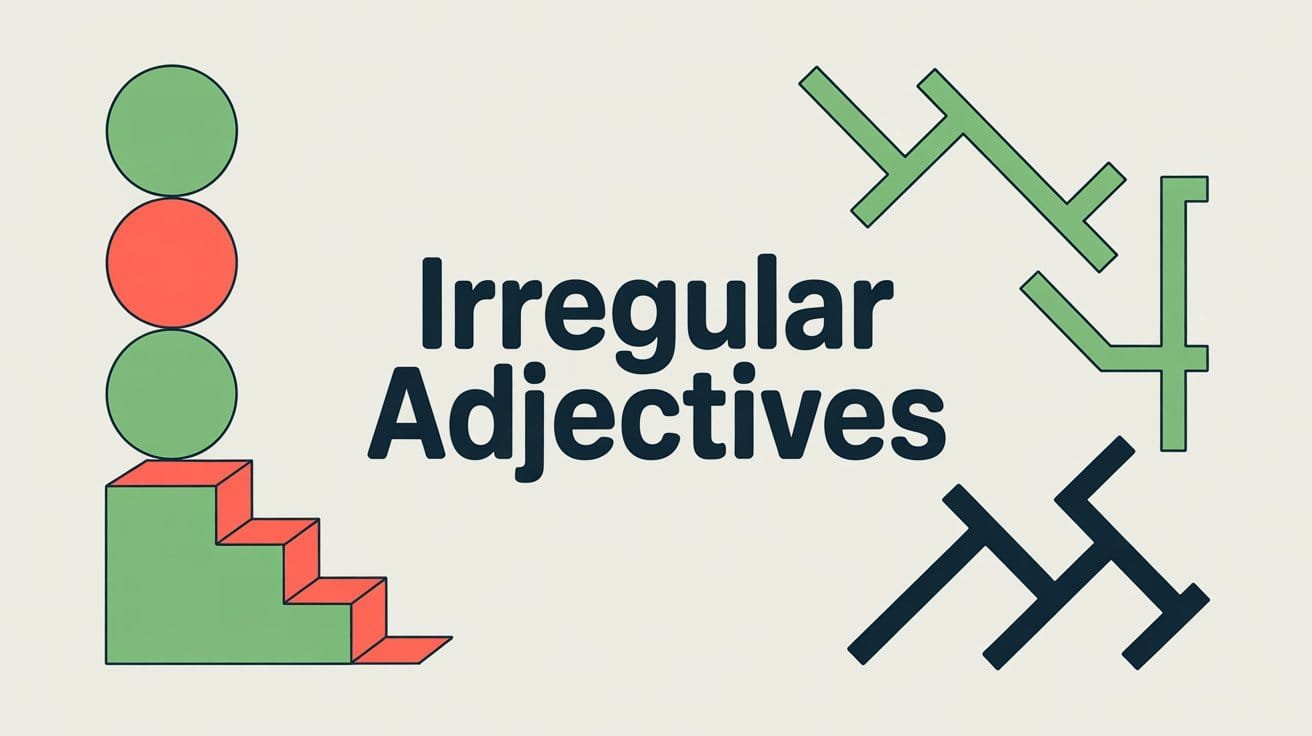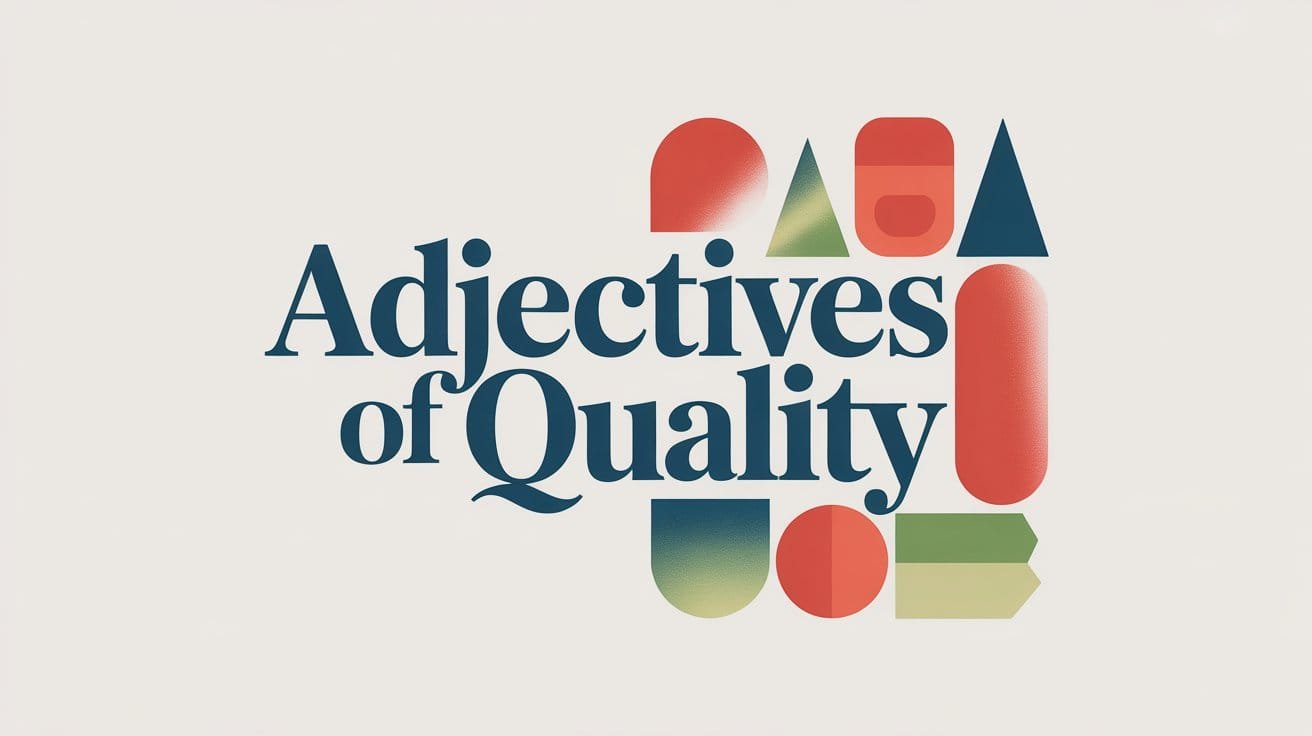Most adjectives in English follow clear rules when you compare things. You add –er or use more to form the comparative, and –est or most for the superlative. But not all adjectives behave this way. Some completely change form when showing comparison. These are called irregular adjectives.
For example, instead of saying gooder or goodest, we say better and best. Words like these don’t follow the normal pattern, and they appear often in everyday English. In this guide, you’ll learn what makes an adjective irregular, explore a list of irregular comparative and superlative adjectives, and see how they’re used correctly in sentences.
What Makes an Adjective Irregular?
An adjective is called irregular when its comparative and superlative forms do not follow the regular pattern of adding –er/–est or using more/most. Instead of changing slightly, these adjectives often take on completely new forms.
For example:
- good → better → best
- bad → worse → worst
These words don’t follow any fixed spelling rule. Their forms have evolved naturally over time. Many irregular adjectives come from Old English, where comparisons were formed differently from modern grammar rules.
Because of their frequency, these adjectives appear everywhere—in casual speech, academic writing, and professional English. Using incorrect forms like gooder or baddest immediately sounds unnatural.
How Irregular Adjectives Differ from Regular Ones
Most adjectives in English are predictable. You can usually guess how to make their comparative and superlative forms:
- Short adjectives (one syllable) often add –er or –est: tall → taller → tallest.
- Longer adjectives use more and most: beautiful → more beautiful → most beautiful.
Irregular adjectives break these patterns completely. They don’t follow sound-based or spelling-based rules — their forms are unique and must be learned individually.
Compare these examples:
- Regular: The building is taller than the old one.
- Irregular: This solution is better than the previous one.
In the regular example, taller comes directly from tall. In the irregular one, good changes form entirely to better, making it impossible to predict from the base word alone. Learning these irregular forms helps you use comparative and superlative adjectives correctly, even when they don’t behave like the rest.
List of Common Irregular Adjectives
Below is a list of the most frequently used irregular adjectives in English, along with their comparative and superlative forms.
| Positive | Comparative | Superlative |
|---|---|---|
| bad | worse | worst |
| far | farther / further | farthest / furthest |
| good | better | best |
| late | later | latest |
| little | less | least |
| many | more | most |
| much | more | most |
| old | older / elder | oldest / eldest |
| well | better | best |
These adjectives are irregular because their forms come from older patterns of English that predate modern grammar rules. A few of these adjectives—such as farther/further and older/elder—also have usage differences depending on meaning or context.
Usage Notes & Contextual Rules
Irregular adjectives follow their own patterns, but their use in sentences often depends on meaning, context, and tone. Some have two accepted forms, while others change depending on what you’re describing.
“Farther” vs. “Further”
Both farther and further come from the adjective far, but over time they’ve developed slightly different meanings depending on what kind of “distance” you’re describing.
In traditional grammar, farther is used for physical distance—something you can measure or travel. Further, on the other hand, tends to refer to figurative or abstract distance, such as progress, time, or degree.
Examples:
- The park is farther than the post office. (physical distance)
- We’ll discuss this further in tomorrow’s meeting. (figurative extension)
The difference isn’t absolute, though. In modern usage, especially in British English, further can be used in both physical and non-physical contexts. You might hear “The school is further down the road” and still be correct.
“Older” vs. “Elder”
Both older and elder come from the adjective old, but they are not used in exactly the same way. While both describe age, their meaning, tone, and context differ slightly.
Older is the general comparative form of old. It’s used for people, animals, or things and works in both formal and informal contexts.
- My car is older than my brother’s.
- She looks older than her actual age.
Elder, however, has a narrower and more traditional use. It’s used only for people, usually to indicate family relationships or respect.
- My elder sister is a doctor.
- His elder son manages the family business.
You’ll often find elder used as a noun too, especially in formal English or community roles (the village elder, church elder). Example: The council of elders met to decide the matter.
“Less” and “Least”
The words less and least come from the adjective little, but they behave differently from the typical comparative (smaller) and superlative (smallest) forms. Instead of describing physical size, less and least are used to talk about amount, quantity, or degree—qualities that can’t easily be counted.
Think of them as ways to compare how much of something exists, not how big or how many things there are.
Examples:
- She spent less time on the project this week.
- That plan requires the least effort but still works well.
In these sentences, less and least describe quantity (time, effort), not size. You wouldn’t say “littler time” or “littlest effort” because little doesn’t make sense in that structure.
When you use less and least, you’re comparing amounts that are not countable—things like money, patience, interest, energy, or effort.
However, English can be flexible. Less sometimes appears with countable nouns in casual conversation: “There were less people at the concert this year.” The standard form is “fewer people,” but native speakers commonly use less in speech for convenience. It’s accepted in everyday English, though fewer remains preferred in formal writing.
“Better” and “Best”
The words better and best are the comparative and superlative forms of good, one of the most frequently used irregular adjectives in English. Unlike regular adjectives that simply add –er or –est, good changes form entirely when expressing degree.
At first glance, better and best seem easy to use. But they carry subtle differences in meaning and tone that go beyond comparison.
Better compares two things or situations, showing improvement, advantage, or preference.
- This plan is better than the previous one.
- You’ll feel better after some rest.
Here, better implies not just comparison but also positive change or improvement. That’s why it often appears with verbs like feel, get, become, or look. For example, “He’s getting better at public speaking.“
Best goes one step further. It identifies something as the highest quality or most favorable option among three or more.
- That was the best performance of the night.
- This is the best solution for long-term results.
In English, better and best also appear in idiomatic expressions, where they express suggestion or evaluation rather than literal comparison:
- You’d better leave now if you want to catch the train.
- Things have changed for the better (meaning: they have improved).
“Worse” and “Worst”
The words worse and worst are the comparative and superlative forms of bad. Like good → better → best, they change completely rather than following the usual –er / –est pattern. Because bad expresses a negative quality, its comparative and superlative forms describe increasing levels of negativity or decline.
Worse compares two things, situations, or conditions that are undesirable. It tells us that one is more bad than the other.
- The weather today is worse than it was yesterday.
- His handwriting is worse now than last year.
Here, worse doesn’t just show difference—it emphasizes a decline in quality or condition. It often appears in discussions about health, performance, or results:
- My cold is getting worse.
- The traffic is worse during the holidays.
Worst identifies the lowest possible point among several negative choices. It’s the opposite of best, used to highlight the most unfavorable or damaging option.
- That was the worst movie I’ve ever seen.
- Of all the candidates, he gave the worst answer.
In English, worse and worst also appear in many common expressions that convey evaluation or empathy:
- For better or worse (meaning through both good and bad situations).
- At worst (meaning in the most negative possible case).
They’re used not just for comparison, but to convey emotional tone or judgment. For example: a worse outcome, the worst experience, or worse than expected.
Examples of Irregular Adjectives in a Sentence
- This solution works better than the last one, and it might be the best option overall.
- His timing is worse than before; that was the worst moment to interrupt.
- The museum is farther than the library, but the art gallery is the farthest from here.
- She has less patience than before and shows the least interest in small talk.
- He received more attention than expected and became the most discussed speaker at the event.
- The train arrived later than usual; the latest update says it’s on time again.
FAQs on Irregular Adjectives
What are irregular adjectives in English?
Irregular adjectives are adjectives that don’t form their comparative and superlative with –er/–est or more/most. For example, good → better → best and bad → worse → worst are irregular because they completely change form instead of following the usual pattern.
How many irregular adjectives are there in English?
There isn’t a fixed number, but English has fewer than a dozen commonly used irregular adjectives. The most frequent ones include good, bad, far, little, much/many, old, and late. These appear regularly in both written and spoken English.
Why are some adjectives irregular?
Irregular forms come from older versions of English. Many were borrowed from Old English or Germanic roots, where comparison worked differently. Over time, most adjectives became regular, but a few kept their older, unique forms—that’s why we still say better and worse instead of gooder and badder.
Can an adjective be both regular and irregular?
Yes. Some adjectives, like old, can take both forms:
older/oldest — general use
elder/eldest — usually for family relationships
Both are correct, but their use depends on context and tone.
What’s the difference between “farther” and “further”?
Both come from far. Farther usually refers to physical distance (The park is farther than the school). Further is used for abstract ideas like time or discussion (We’ll talk about this further tomorrow).
Do irregular adjectives have adverb forms?
Yes, some do. For example:
well → better → best (adverb form of good)
badly → worse → worst (adverb form of bad)
These follow the same irregular pattern but function as adverbs in sentences.



